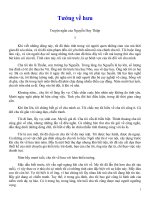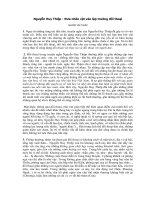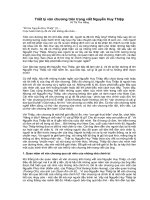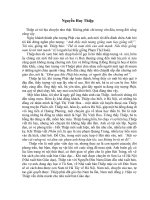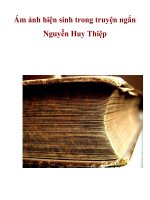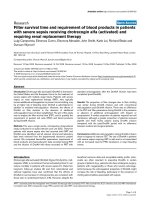Nguyen Huy Thiep’s salt of the Jungle in comparision with ernest hemingway’s the old man and the sea from ecological criticism
Bạn đang xem bản rút gọn của tài liệu. Xem và tải ngay bản đầy đủ của tài liệu tại đây (317.81 KB, 9 trang )
TRƯỜNG ĐẠI HỌC SƯ PHẠM TP HỒ CHÍ MINH
HO CHI MINH CITY UNIVERSITY OF EDUCATION
TẠP CHÍ KHOA HỌC
JOURNAL OF SCIENCE
KHOA HỌC XÃ HỘI VÀ NHÂN VĂN
SOCIAL SCIENCES AND HUMANITIES
ISSN:
1859-3100 Tập 16, Số 7 (2019): 114-122
Vol. 16, No. 7 (2019): 114-122
Email: ; Website:
Research Article
NGUYEN HUY THIEP’S SALT OF THE JUNGLE1
IN COMPARISION WITH
ERNEST HEMINGWAY’S THE OLD MAN AND THE SEA
FROM ECOLOGICAL CRITICISM
Phan Thi Thu Hien
University of Social Sciences and Humanities - Vietnam National University - Ho Chi Minh City
Corresponding author: Phan Thi Thu Hien – Email:
Received: April 08, 2019; Revised: June 16, 2019; Accepted: July 10, 2019
ABSTRACT
Both The Old Man and the Sea and Salt of the Jungle are profound messages of “live and
lets live”: living in harmony between human and nature is crucial to ensure man’s well-being as
well as the earth’s living. While Hemingway tried to seek an inner balance between “respecting
nature” and “conquering nature”, Nguyen Huy Thiep did not only praise the nature but also think
of threats of ecological crisis due to human’s selfish behavior toward the environment. The work
advocates ecological holism and criticizes people who destroy nature.
Keywords: ecocriticism, comparative study, Nguyen Huy Thiep, Ernest Hemingway, The
Old Man and the Sea, Salt of the Jungle.
Introduction
The Old Man and the Sea is the best novel of Ernest Hemingway (1899-1961) which
plays a significant contribution to bringing him the Nobel Prize. Salt of the Jungle is also
considered as one of the best short stories of Nguyen Huy Thiep which is translated into
English, French, Italian, Swedish, and Korean. Both works, as expected, will continue to
be included in the High School Literature program in Vietnam. This paper is a comparative
study of these works from the ecological perspective. Through the same projection, it may
reveal new dimensions of them.
1.
The similarities between The Old Man and the Sea and “Salt of the Jungle”
There are many noticeable similarities between the two works.
The Old Man and the Sea’s plot focuses on 3-day fishing trip and Salt of the Jungle’s
one on (about) 3-hour hunting trip. At the end, both the fishermen and the hunter returned
home with empty hands.
The titles of the two works are very close to each other. Both of the “sea” and the
“jungle” are infinite and wild spaces contrasting with the little “old man” and “salt”.
The names of the main characters in both E. Hemingway’s and Nguyen Huy Thiep’s
works are with obscured nuances. If “Santiago” may suggest the name of a saint, “Dieu”
Cite this article as: Phan Thi Thu Hien (2019). Nguyen Huy Thiep’s Salt of the Jungle1 in comparision with
Ernest Hemingway’s The Old Man and the Sea from ecological criticism. Ho Chi Minh City University of
Education Journal of Science, 16(7), 114-122.
114
Tạp chí Khoa học Trường ĐHSP TPHCM
Phan Thi Thu Hien
may evoke the French word with meaning of “God”. Both characters are not shown
vividly, full details of biography and appearance. Alone in the sea or in the forest, they
often use monologue. The character’s viewpoint becomes dominant.
The voice of both The Old Man and the Sea and Salt of the Jungle are lyrical. This is
contrasting with the “neutral” and “stolid” voice of most of Hemingway’s as well as
Nguyen Huy Thiep’s works.
Both The Old Man and the Sea and Salt of the Jungle are nurtured by the authors for
a long time. The story of The Old Man and the Sea had been in E. Hemingway’s mind for
16 years:
“In 1936, Hemingway wrote an essay for Esquire that contained a paragraph
describing an “old man fishing alone in a skiff out of Cabañas” who hooked a big marlin
(…) In 1952, he returned to the story” (Joy Lanzendorfer, 27/5/2015).
The image of “tu huyen” flower and the ecological concern obsessed Nguyen Huy
Thiep’s mind from 1970’s, about 10-15 years before their appearance in Salt of the Jungle
in 1986.
Muong Lum is a very remote place in Yen Chau. In 1970s, there was not any road
here. (…) The mountain range was full of towering peaks. Many monkeys climb on cliffs
skillfully. O youth! Adventurous trips! Which mystical “tu huyen” flower is waiting at the
end of the trip? Fog... The rains suddenly poured down. Going deep into jungle to feel its
taste and be touched intensely… In front of nature, it turns out that man is the most
meaningless and arrogant… (Nguyen Huy Thiep, 2019)
The Old Man and the Sea shows brilliantly the “principle of the iceberg” of
Hemingway’s minimalist style. Salt of the Jungle shows the style of Nguyen Huy Thiep
who believes that the writer’s duty is “to create characters, to set out situations for his
readers to think”.
Many surprising similarities between The Old Man and the Sea and Salt of the
Jungle may make some people wonder whether Nguyen Huy Thiep was influenced by
Hemingway. At the meeting of writers whose works were included in the Literature
program with high school teachers at Hanoi Cultural University on July 16, 2018, Nguyen
Huy Thiep revealed that “The origin of Salt of the Jungle is The Old Man and the Sea.”
However, he only heard about the content, but not had read Hemingway's work. (Sports
and Culture, 19/7/2018)
Inspired from The Old Man and the Sea, Nguyen Huy Thiep truly opened up a new
creation in Salt of the Jungle.
2.
The relationship between Man and Nature in The Old Man and the Sea and Salt
of the Jungle
The Old Man and the Sea opens with Santiago who was considered an unlucky
fisherman after 84 days without catching a fish, went fishing alone. After catching a giant
marlin, he was forced to fight with sharks and at the end, the sharks had devoured the
marlin, only leaving its skeleton. The work’s central theme is the human spirit to cope with
harsh challenges, refuse to be subdued. The theme of Man and Nature is a sub-theme, but
one of the most important sub-themes.
115
Tạp chí Khoa học Trường ĐHSP TPHCM
Tập 16, Số 7 (2019): 114-122
Fishing is Santiago’s livelihood. The human lives depend on nature’s nurture.
Santiago thought of the sea with his gratitude, moreover, with his love. Even the sea’s
rigors, he still considers as “natural”:
He always thought of the sea as la mar which is what people call her in Spanish
when they love her. Sometimes when they love her. Sometimes those who love her say bad
things of her but they are always said as though she were a woman. Some of the younger
fishermen, those who used buoys as floats for their lines and had motor-boats, bought
when the shark lives had brought much money, spoke of her as el mar which is masculine.
They spoke of her as a contestant or a place or even an enemy. But the old man always
thought of her as feminine and as something that gave or withheld great favors, and if she
did wild or wicked things it was because she could not help them. The moon affects her as
it does a woman, he thought.”
It’s noteworthy that Santiago contrasts the “feminine” cognitive of the sea as a
mother/ a lover by an old fisherman on a small wooden boat, using human labor and
natural materials, with the “masculine” cognitive of the sea as a contestant/ a place/ an
enemy by young fishers on motorboats, using industrial products. The different is not
individual but generational. Rather, it is the difference between “modern” and
“traditional”, “cultural” and “civilized”, “physical” and “spiritual” people. Santiago
belongs to the ancient world where people live and coexist with nature, cultivate a closed
and warm relation with nature.
Santiago views other sea creatures as sharing the universe like a big common home
with humans. The sun, the moon, stars are his distant friends. The experiences of his long
life at the sea make him understand behavior of each marine species like his relatives. He
loves flying fishes waking up early (p.19). He “had a friendly contempt for the huge, stupid
logger-heads, yellow in their armor-plating, strange in their love-making, and happily
eating the Portuguese men-of-war with their eyes shut”. He can identify the difference in
voice between two porpoise playing and loving one another: “the blowing noise the male
made and the sighing blow of the female”…
Santiago finds the marine life just like human society. There are small and weak
creatures which have to earn living very hard while big and strong ones always bully
others. In the same species (as shark) there are also different kinds: noble and mean:
“He was sorry for the birds, especially the small delicate dark terns that were always
flying and looking and almost never finding, and he thought. The birds have a harder life
than we do except for the robber birds and the heavy strong ones”
“He (a dentuso – a kind of shark) lives on the live fish as you do. He is not a
scavenger nor just a moving appetite as some sharks are. He is beautiful and noble and
knows no fear of anything”.
Santiago uses many adjectives of human qualities for identifying birds, fish, turtles,
lions. These are not rhetorical measures such as metaphor or personalization. The old man
finds those adjectives appropriate to describe activities and demeanor of the animals.
116
Tạp chí Khoa học Trường ĐHSP TPHCM
Phan Thi Thu Hien
After his wife died and the boy Manolin left, while fishing alone, Santiago began to
form a habit of talking aloud to fishes, birds as well as to his hands, his head… and talking
to himself. He resists to loneliness just as resists to defeat. It is a close association with
nature that sustains him in coping with all challenges.
Santiago considers the great marlin not only his opponent but also his “friend”, his
“brother” and more:
“Then he began to pity the great fish that he had hooked. He is wonderful and
strange and who knows how old he is, he thought. Never have I had such a strong fish nor
one who acted so strangely. Perhaps he is too wise to jump. He could ruin me by jumping
or by a wild rush. But perhaps he had been hooked many times before and he knows that
this is how he should make his fight. (…) He took the bait like a male and he pulls like a
male and his fight has no panic in it.”
Santiago identified the marlin as male and imagined him as old because of his
mindfulness. Santiago’s way of admiring the marlin is familiar to his way of respecting of
his idol, DiMaggio. The qualities of the marlin such as endurance, experience, calm,
wise… are exactly the qualities which Santiago believes he still preserves despite his
aging. More than a worthy opponent, a soul mate, the marlin is considered by Santiago as
his alter-ago.
The struggle with the marlin is the process of Santiago’s improving himself.
Santiago’s trying his best to subdue the marlin, in fact, is his trying to face and transcend
his weakness.
The central theme of Salt of the Jungle is the relation between Man and Nature. The
work opens with the image of Mr. Dieu who went into the jungle, carrying the gun.
Hunting is Mr. Dieu’s pastime. He departed for killing creatures with very carefree steps as
if man has the right of conquering nature for his selfish interests.
Different with Santiago’s admire for his marlin’s nobility, Mr. Dieu found the male
monkey is worthy with his modern gun. He poured on the male monkey all the longsuffering that he had contained in his heart, the grudge he brought from the society outside
into the forest. Just having seen the leader-monkey, he cursed: “The ignoble father! The
lustful! The patriarchal! The dirty lawmaker!”. Without faith in human ethical values, Mr.
Dieu’s interpretations of animal nature become distorted. He found bestiality multiply
despised.
Similarly, Mr. Dieu thought with prejudice when seeing the female monkey going to
her injured mate and lifting him up in her arms:
Mr. Dieu angrily raise his shotgun. Her readiness to sacrifice herself made him hate
her like some bourgeois madame who paraded her noble nature.
While those adjective identifying human qualities which Santiago ascribed to birds
and fishes are based on his lifetime’s knowledge of animals just “as-they-are”, Mr. Dieu
adjectives reveal his way of taking master authority to judge and impose preconceptions
toward animals such as his way of taking master authority to decide their fates.
117
Tạp chí Khoa học Trường ĐHSP TPHCM
Tập 16, Số 7 (2019): 114-122
But then, the behavior of monkey family after the male monkey was shot by Mr.
Dieu forces him to change his opinions. From thinking of animals as inhuman, inferior
than men, Mr. Dieu gradually comes to recognize them as fellow, even as superior than
some humans in emotional, spiritual values.
Seeing the female monkey taking her mate by the hand and running off, Mr. Dieu
thought sadly: “With a pair of arthritic legs like yours, how are you going to run as fast as
a monkey driven by loyalty and devotion?”
Then the baby monkey suddenly appeared. “It grabbed the sling of the shotgun and
dragged it off along the ground”:
Mr. Dieu drew back in fear, as a mist swirled up from the abyss and enveloped the
vegetation around him. Very quickly the entire landscape was obscured by eerie vapors.
It had been a white monkey that seized the gun. Moreover, this had been such an
extraordinary action that Mr. Dieu began to wonder if what he had been chasing was
really a monkey. Am I dreaming? he wondered, looking around. Is all of this happening?
He stood up and looked at the mountain wall on the other side of Death Hollow. He was
stunned, for now, without a trace of mist, the dome of the sky was clear and vast, and the
entire landscape was visible in every detail.
The baby monkey carelessly stumbled down, or he deliberately sacrifices himself to
destroy the gun as a killing weapon? The baby monkey “was too inexperienced to react in
any other way” or he was wiser than adults? Mr. Dieu gazed in awe at the abyss and after
that was overwhelmed with soaring peaks. He saw mist obscured the entire landscape and
quickly cleared off for everything visible in every detail. Is here mainly the landscape of
Mr. Dieu’s mindset, from ignorance’s darkness to awakening’s light?
At a closed distance, he suddenly became thrilling when seeing the male monkey, in
his pain, looks like only a poor child:
“The monkey curled its body into a ball and again turned its moist eyes toward Mr.
Dieu. The old man looked away. (…) The monkey then buried its head in Mr. Dieu's arms,
and a stammering sound came out of its mouth. The monkey was like a helpless child
imploring him for help. Mr. Dieu felt very miserable. “It is better for me if you resist,’ he
murmured, looking down at the suffering brow of the shriveled monkey. “I am old, and you
know the sympathy of old people is easily aroused.”
One of important differences between Salt of the Jungle and The Old Man and the
Sea is that on the scale of fellow levels, Mr. Dieu’ s monkey is located much closer with
human than Santiago’s fish. While Santiago’s marlin is dumb, Mr. Dieu’s monkey can
“talk” (through sub-verbal, non-verbal means) to him. Especially, in the case of injury, the
monkey’s expression becomes more dramatically touched.
At the beginning, Mr. Dieu was a coldly hunter who calmly and carefully
concentrates on the preciseness in every movement, every gesture to hit the target. Now he
became confused because of awakened sensibility. The most difficult thing to endure for
him is feeling tormented, regretful, and ashamed of his wrong behavior.
In Mr. Dieu’ s thoughts, sometimes hidden complexities about human’s inferiority
are revealed. He found human not nobler than other creatures but in fact, the most
118
Tạp chí Khoa học Trường ĐHSP TPHCM
Phan Thi Thu Hien
dishonorable, insidious, and ruthless. When the female monkey despite the dangers still
followed Mr. Dieu and the male monkey, Mr. Dieu not only felt being humbled par with
animals but also found himself as inferior.
“The trio continued to plod on through the jungle. The female monkey was incredibly
persistent, and made Mr. Dieumfeel that it was all so terribly unfair”.
Finally, not only because of physical fatigue (“the monkey's hands clawed at Mr.
Dieu's chest and made it bleed”) but it is his conscience that made him throw the monkey
down on the ground:
“As Mr. Dieu now looked at both the monkey, he felt a burning sensation on the
bridge of his nose. Profoundly sad, he was overcome by the realization that, in life,
responsibility weighs heavily on every living thing. “All right, I'll set you free”, declared
Mr. Dieu.
Santiago’s character in The Old Man and the Sea is mainly consistent. On the
contrary, Mr. Dieu’s character in Salt of the Jungle is in the process of change: his
viewpoints, feelings, and attitudes toward nature are even reversed. His separation and
rivalry toward nature when entering the jungle are changed into sympathy and harmony
when going out of the jungle. He goes from arrogance to humility, from disdain to respect
toward nature.
3.
The ecological theme in relation with the message of “the Grace” in The Old
Man and the Sea and Salt of the Jungle
In The Old Man and the Sea, the challenges, like waves, happened continuously - the
latter are harsher than the former – and gradually deprived almost every strength as well as
weapon of the central hero. In the struggling with the marlin and sharks, Santiago had
gradually a wounded eye, bled right arm, being cramped right hand, pained back… His
weapons such as the spear, the knife, the pestle, the boat handlebar were gradually taken by
sharks or broken. The hero was deprived of all material forces, all external resources. He is
forced to rely on only his mental strength, his inner strength.
It is significant that Santiago’s mental strength is nurtured, enhanced through his
unifying himself with nature. That is why, multiple times, Santiago thinks of his sin of
killing the great marlin:
“I’ll kill him though”, he said. “In all his greatness and his glory”. Although it is
unjust, he thought. But I will show him what a man can do and what a man endures”.
Finally, Santiago finds both human and fishes, shrimps, birds, animals... alternately
have to kill and be killed, have to become food for each other, in other word, everything
involves the universe’s circle in which these deaths are sacrificed for other lives.
“Besides, he thought, everything kills else in some way. Fishing kills me exactly as it
keeps me alive”.
The rule seems very rational, practical, natural and at the same time very
unreasonable, unjust, cruel. Santiago, although sensitive, is still forced to accept this rule in
marine as well in society.
119
Tạp chí Khoa học Trường ĐHSP TPHCM
Tập 16, Số 7 (2019): 114-122
At the end, when the boy Manolin decided to return to fishing together with the old
man, it seemed that Santiago’s life is transformed into his offspring. The old man slept,
with posture like executed Christ on the cross, but his dream of lions became brightened
with Easter blessing. The legacy which Santiago would give to the boy Manolin includes
not only his courage and pride but also his love and pity.
In comparison with stoic heroes who are familiar in almost Hemingway’s works
before The Old Man and the Sea, Santiago gave a new dimension, a universe dimension to
the pressures in human struggle for existence. As the writer of “the lost generation”,
Hemingway now became a spokesman for “a loss-enduring human”.
William Faulkner (1897-1962), an American famous writer who also got Nobel and
Pulitzer awards as Hemingway, had published in the journal Shenandoah his glorification
of The Old Man and the Sea:
Time may show it to be the best single piece of any of us, I mean his and my
contemporaries. (…) Until now, his men and women had made themselves, shaped
themselves out of their own clay; their victories and defeats were at the hands of each other,
just to prove to themselves or one another how tough they could be. But this time, he wrote
about pity: about something somewhere that made them all: the old man who had to catch
the fish and then lose it, the fish that had to be caught and then lost, the sharks which had to
rob the old man of his fish; made them all and loved them all and pitied them all.” (Joy
Lanzendorfer, 27/5/2015).
Before The Old Man and the Sea, for over a decade, Hemingway had not written any
significant work, like skilled Santiago, during 84 days not catching any fish. When
Hemingway sent the manuscript to his editor, Wallace Meyer, he said, “I know that it is the
best I can write ever for all of my life, I think, and that it destroys good and able work by
being placed alongside of it.” (Joy Lanzendorfer, 27/5/2015).
In The Old Man and the Sea, Hemingway basically remains loyalty to his “stoic” style of
writing. However, different with almost his works before it, The Old Man and the Sea is
deeply emotional and deeply poetic. It likes a Life-Farewell Song or a Testament Poem.
In Salt of the Jungle there is also a journey when the central character gradually
being deprived everything.
The work opens with the image of Mr. Dieu carrying his gun, “put on a warm quilted
coat and trousers, a fur hat, and laced up a pair of high boots. To be well prepared, he
also took a ration of sticky rice rolled into a ball the size of his fist”.
After Mr. Dieu shot at the-leader monkey, his gun was seized by the baby monkey.
From climbing easily, he took of his boots and outer garments. Finally, he took off his
shorts and using them to bandage the monkey’s wound.
Naked now, Mr. Dieu picked the monkey up and kept adjusting its weight in his arms
as he found his way back down the mountain. Then, suddenly, as though impelled by some
force, the mountainside began to slide away with a tremendous roar from about halfway
up. An avalanche! Mr. Dieu jumped in terror and clung tightly to a rock. A section of the
path he had taken to come up the mountain now flashed down past him, leaving only the
surface of the rock shorn smooth. Mr. Dieu could no longer see the mulberry tree where he
120
Tạp chí Khoa học Trường ĐHSP TPHCM
Phan Thi Thu Hien
had left his boots and outer garments. (…) When Mr. Dieu reached the clump of bushes
and vines, he had hidden behind that morning, he stopped to pick up his hat and coat and
the ball of sticky rice he had left there. But, to his astonishment, he found that a termites'
nest as tall as rice stubble had risen in that spot.
While Santiago’s being gradually deprived his spear, knife, pestle, boat handlebar…
is narrated in a realistic, natural, logical way, Mr. Dieu’ s being lost his gun, clothes, shoes,
food like a nightmare, very irrational, abnormal, weird. From the baby monkey to
avalanche, termite’s nest… as if every creature as well as everything in jungle is burning
with anger, unanimously retaliate to Mr. Dieu. The series of nature’s extraordinary
reactions in unpredictable places and times made him know how to fear mysterious hidden
power. Doing evil with nature, human must be destroyed by nature just as the causal law
familiar with Oriental traditional way of thinking: “Reap what you sow”.
After setting the male monkey free, Mr. Dieu came out of the jungle:
“Mr. Dieu turned onto another track because he wanted to avoid people. This track
was choked with bramble bushes that made the going difficult, but they were covered by
masses of tu huyen flowers. Mr. Dieu stopped in amazement tu huyen flowers bloom only
once in thirty years, and people that come across them are said to meet with good luck.
The flowers are white. They are as small as the head of a toothpick and have a salty taste.
People call them “salt of the jungle.” When the jungle is braided together with these
flowers, it is a sign that the country is blessed with peace and abundant harvests”.
Once again, the atmosphere suddenly changed into legendary. Mr. Dieu as an
ignorant and violent man at the beginning was being purified, awakened, moreover,
sublimated under the graceful sky of “tu huyen” flowers.
“When he came out of the valley, Mr. Dieu went down into the fields. The spring rain
was gentle but very good for the rice seeds. Naked and lonely, he went on his way. A little
later, his shadow faded into the curtain of rain.”
No longer like an arrogant conqueror, Mr. Dieu became a small element dissolving in
nature. As if the man carrying a gun at the beginning has died together with the old winter and
another pristine man newly born from the jungle’s womb is purified with early spring rain.
Nguyen Huy Thiep wrote Salt of the Jungle and many other short stories in The
Winds of Hua Tat at age of 30s, using the materials and experiences accumulated at age of
20s when he was a teacher in Northwestern area.
With “tu huyen” flowers as a seal, with the rebirth motif, Mr. Dieu’ s trip into the
jungle is depicted as an initiation rite. Wild and pristine jungle is seen not only as
contrasting with civilized society but also as a sublime place where one can have his
delusive and childish ego bathed and rediscover his true nature.
Conclusion
The Old Man and the Sea (1952) by E. Hemingway and Salt of the Jungle (1986) by
Nguyen Huy Thiep can be considered as outstanding works of a rich and diverse ecological
literature of the 20th century through its process of formation and development.
121
Tạp chí Khoa học Trường ĐHSP TPHCM
Tập 16, Số 7 (2019): 114-122
Both The Old Man and the Sea and Salt of the Jungle are profound messages of “live
and lets live”: living in harmony between human and nature is crucial to ensure man’s
well-being as well as the earth’s living. While Hemingway tried to seek an inner balance
between “respecting nature” and “conquering nature”, Nguyen Huy Thiep did not only
praise the nature but also think of threats of ecological crisis due to human’s selfish
behavior toward environment. The work advocates ecological holism and criticizes people
who destroy nature.
Conflict of Interest: Author have no conflict of interest to declare.
REFERENCES
Carlos Baker (editor). (2003). Ernest Hemingway Selected Letters 1917-1961. Scribner Publisher.
Dang Thai Ha. (01/5/2015). Understanding of Nguyen Huy Thiep’s stories from ecocriticism.
Retrieved from />Ernest Hemingway. (2004). The Old Man and the Sea. Arrow Books.
Joy Lanzendorfer. (27/5/2015). 11 facts about Hemingway’s The Old Man and the Sea, Retrieved
from />Nguyen Huy Thiep (translated by Greg Lockhart). (13/9/2016). Salt of the Jungle, Retrieved from
/>Nguyen Huy Thiep. (29/6/2019). “Some notes in my works”, Raising nets to catch birds,
/>Sports and Culture. (19/7/2018). The writer Nguyen Huy Thiep: “I am only a single wanderer in
my journey”. Retrieved from />Tran Quoc Hoi. (7/4/2011). A little of spice in “Salt of the Jungle”. Retrieved from
rung.html
MUỐI CỦA RỪNG (NGUYỄN HUY THIỆP)
TRONG SO SÁNH VỚI ÔNG GIÀ VÀ BIỂN CẢ (HEMINGWAY)
TỪ GÓC NHÌN SINH THÁI
Phan Thị Thu Hiền
Trường Đại học Khoa học Xã hội và Nhân văn – ĐHQG TPHCM
Tác giả liên hệ: Phan Thị Thu Hiền – Email:
Ngày nhận bài: 08-4-2019; ngày nhận bài sửa: 16-6-2019; ngày duyệt đăng: 10-7-2019
TÓM TẮT
Ông già và Biển cả cũng như Muối của rừng đều mang đến những thông điệp sâu sắc về
quan hệ “sống và cùng chung sống” giữa con người với tự nhiên như đảm bảo cho hạnh phúc
nhân loại và sự sống trên Trái Đất. Trong khi tiểu thuyết của Hemingway thể hiện mong muốn tìm
kiếm điểm cân bằng nội tâm giữa tôn trọng, hòa nhập với tự nhiên và chinh phục tự nhiên, truyện
ngắn của Nguyễn Huy Thiệp suy tư về mối đe dọa khủng hoảng sinh thái, những tương tác giữa
tiến hóa văn minh và quan hệ đạo đức của con người với môi trường sống của họ.
Từ khóa: phê bình sinh thái, nghiên cứu so sánh, Nguyễn Huy Thiệp, Ernest Hemingway,
Ông già và biển cả, Muối của rừng.
122
